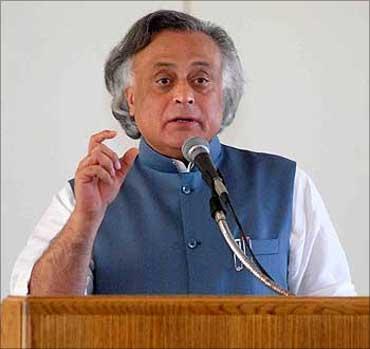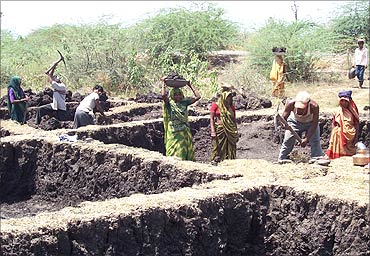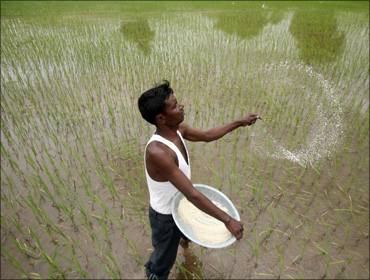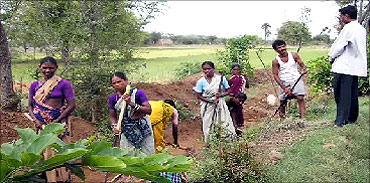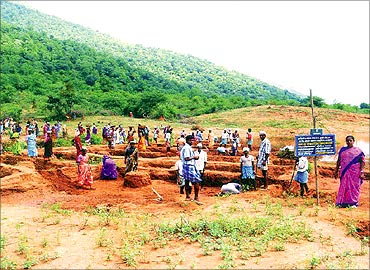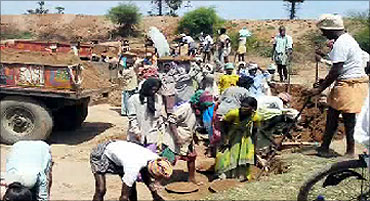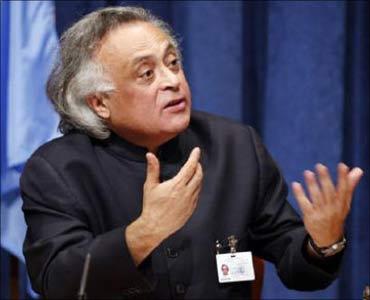 | « Back to article | Print this article |
Will Jairam Ramesh's new plan fix NREGA?
The new rural development minister wants to use technology to force states to make payments. Critics suggest that he should fix existing problems first.
Jairam Ramesh is not afraid of stirring things up. Sixty days into his stint as the new Rural Development Minister, Ramesh, he has unveiled what he calls NREGA 2.0, a reform package that he feels would make the Rs 40,000 crore (Rs 400 billion) programme actually work.
Ramesh has put together suggestions by a group of civil society members, called the Consortium of NREGA NGOs led by Planning Commission member Mihir Shah, which would act as the de-facto road map for a makeover of the UPA Government's aam admi show piece scheme.
Click NEXT to read more
Will Jairam Ramesh's new plan fix NREGA?
The chief reform that he proposes is to ensure guaranteed work to those who demand it.
So far, despite the Act guaranteeing a hundred days of work per person to any rural household on demand, people's efforts to get NREGA jobs have been stymied by the fact that governments have done nothing to register demands.
Average number of days worked per person under the program has steadily fallen over the years, to 46.79 days in 2010-11.
Many potential workers are illiterate so written demands are not an option. They have usually worked only when summoned, as was the case in the earlier Food for Work programme.
Click NEXT to read more
Will Jairam Ramesh's new plan fix NREGA?
The main reason why states did not entertain demands was that under the Act, the failure to provide work in 15 days would attract an unemployment allowance which no state has paid in the last five years.
This time, the aim is to automatically capture all demands by the emerging holy grail of all such government initiatives-information technology.
The minister, for instance, plans to introduce telephonic registration of work demands which would then be reflected in the MIS data that would be embedded on the job card of the NREGA worker.
Unemployment allowance would then accrue against the name of the worker to which the state would be obliged to pay, or face an audit - a feature that is also being introduced in the retooled plan.
Click NEXT to read more
Will Jairam Ramesh's new plan fix NREGA?
In other words, literate or not, all the workers would have to do is leave a voice mail about the desire for a job, and if that demand is not met within fifteen days the state would have to shell out the minimum guarantee.
The proposal also talks of identifying suitable service providers for an interactive voice recorder service. (It also proposes mandatory quarterly meetings of the panchayat which would settle payment of unemployment allowance for all demands which are not met.)
Yet, activists say that this proposal, as well as the rest in the 'new and improved' package, is nothing but hot air with no substance.
Click NEXT to read more
Will Jairam Ramesh's new plan fix NREGA?
"Registering every demand for work is linked to paying unemployment allowance. The failure to deliver on registration of demand falls on a third party. The Centre does not have to pay," says KS Gopal former member of the Central Employment Guarantee Council under NREGA.
He says the ministry could instead fix the existing national helpline and make it work and solve problems such as the overwhelming use of Hindi for a scheme that is being implemented across the breadth of the country.
Development Economist Reetika Khera calls it lazy thinking and lip service. "First you get the basics in place. Delays in payment of wages are killing the programme and people are no longer willing to work.''
Click NEXT to read more
Will Jairam Ramesh's new plan fix NREGA?
The minister's solution to this is to deploy business correspondents (BCs) to ensure payments get to workers.
"What does the BC do if Centre does not pay and the district is not willing to approve work?'' she asks. "You need staff to implement the programme and proper oversight mechanism. What is offered now is nothing but a rehash of what former minister CP Joshi proposed as NREGA 2,'' she says.
However, Nikhil De a member of the Central Guarantee Council and an activist of the MKSS in Rajasthan says that it is certainly a step forward. "It covers a lot and the social audit rules have already been notified. The ministry has asked for suggestions and thus is paving way for more changes," but Gopal wonders whether the proposal is in fact suggesting anything new to begin with.
Will Jairam Ramesh's new plan fix NREGA?
"The reforms suggested talk of land development and water sheds but what is it that NREGA offers that is already not being offered through other schemes? And what do water surplus states like Bihar and Bengal do to use the scheme for improvement of their productivity in agriculture? We had addressed those issues in the working group report made for the CEGC. But the ministry, while professing to have considered them, has not taken any advice," he says.
Without convergence with agriculture, the scheme cannot help productivity, says Gopal.
Jairam Ramesh, who has notified use of NREGA funds for making playgrounds and toilets in villages, has however said a firm no to convergence of any sort thus leaving no scope for things like soil improvement and fodder production which the KS Gopal led group had suggested.Click NEXT to read more
Will Jairam Ramesh's new plan fix NREGA?
The plan has other features: It also talks of creating an annual plan of work for each Gram Panchayat which would lead to creating work orders to be given at the beginning of the financial year to workers' families in villages.
It also suggests planning at the cluster level and the habitation level, besides a revolving fund in the states for NREGA, as well as creation of a shelf of projects for two years at a time.
How well these ideas can be translated into reality and the mechanism through which states can be persuaded to follow these measures is to be seen, say critics.
Will Jairam Ramesh's new plan fix NREGA?
A successful rebooting of NREGA should make the UPA government considerably happy.
It may not. In an ironic twist, if the plan actually achieves the impossible of capturing all work demand of various rural households, the NREGA annual allocation would have to go up several times, which would upset the Union Budget.
Then Ramesh could butt heads with finance Minister Pranab Mukherji. (The Rural Development Ministry has so far been spending only around fifty to sixty per cent of the money allocated for NREGA thanks to the failure of the scheme.)
Will Jairam Ramesh's new plan fix NREGA?
Ramesh acknowledged this lightheartedly: "If the demand is actually captured and work provided, then the budget may go up several times, may run into a lakh crore; the Finance Minister will certainly not be pleased.''
Perhaps, one of the reasons for his ease despite this complication could stem from the fact that no state would follow the rules dictated by his ministry and dip into its coffers in order to cough up unemployment allowances.
Problem is, that's part of the problem that Ramesh wants to fix.
Click NEXT to read more
Will Jairam Ramesh's new plan fix NREGA?
Making NREGA work
* Ramesh's new initiative has been aided by a consortium of NGOs led by Planning Commission member Mihir Shah
* Efforts to get NREGA jobs have been stymied by state governments who are unwilling to register demands
* His solution is to use embedded data on job cards and voice mails that show evidence of demand
* Critics suggest focusing on getting basics right first -such as delays in wage payments and convergence issues
* Ironically, if the plan succeeds, its allocation will balloon, upsetting the Union Budget and therefore Pranab Mukherjee
